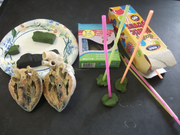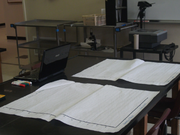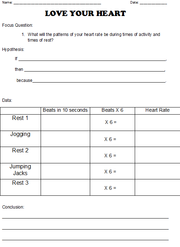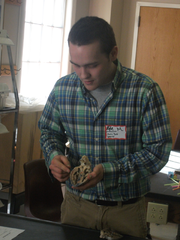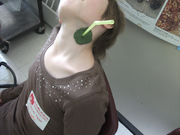Love Your Heart
| Instant wiki maker | Making handouts | Editing tips |
Contents
- 1 Student worthiness
- 2 Primary biological content area covered
- 3 Materials
- 4
- 5 Handouts
- 6 Description of activity
- 7 Lesson plan
- 8 Potential pitfalls
- 9 Math connections
- 10 Literature connections
- 11 Health connections
- 12 Connections to educational standards
- 13 Next steps
- 14 Reflections
- 15 Citations and links
- 16
Biology In Elementary Schools is a Saint Michael's College student project from a course that ran between 2007 and 2010 and fully described in this book chapter. The student-created resources have been preserved here for posterity. Link under 'toolbox' for printer-friendly versions of the exercises. Click on handouts to print full resolution versions. Please see Wikieducator's disclaimer, our safety statement, and the Creative Commons licensing in English and in legalese.
Student worthiness
Tried once and worked well.
Primary biological content area covered
Learning the structure of the heart, observing the pulsation of blood, and measuring your own heart rate.
Materials
For Teacher Use
- A plasticized sheep's heart or other heart model (optional)
Distributed to Each Student by Teacher
- Clay for each student pair
- Two straws for each student pair
- Worksheet
- Calculator (optional if multiplication has not been covered)
For Student Use
- 2 large graphs to record data (it is helpful to have these made before class)
Handouts
This worksheet has students work on the scientific method. They are asked to produce a hypothesis, record data in a chart, and finally producing a conclusion using data to tell what they learned. This worksheet can be changed depending on grade level.
Description of activity
This activity is two folds: The first activity will involve the students testing their heart beat. The students will use straws with clay at one end, placing the clay end on the pulse on their neck (underneath their jaw). The second part of the activity will involve a series of 30 seconds exercise (either jumping jacks or jogging in place), and then placing the clay and straw over their pulse again to observe their heart rate after exercise. Each student will record their findings/heart rate (which is found by counting the number of beats and multiplying this number by 6). Within each activity we will discuss what is happening with the hearts action and how blood is flowing in and out using the sheep's heart as a model.
Lesson plan
- Before Lesson:
- Prepare two large graphs like shown in Figure 1
- Set up tables with straws and clay
- During Lesson:
- Ask students what they know about the heart, such as where is it, what does it do, etc.
- Explain the heart and show the sheep's heart (if kids are not squeamish and are careful the heart should be passed around)
- Explain what a pulse is to students. Highlight the fact that your pulse fluctuates during rest and activity.
- Have students come up with a hypothesis to answer the focus question written on the worksheet
- Separate students into pairs and have them make the pulse readers by attaching a ball of clay at the bottom of a straw
- Have students find their pulse (the best way to find a pulse is located under the jaw directly below the corner of their mouth). Once found, one student will keep the pulse reader and place it on their pulse on their neck. For best results, work with the clay before to soften it. Make sure the student running the experiment is leaning far enough back to ensure the clay will pulse reader will stay on their neck without holding it. The other student will count the amount of times it jumps in 10 seconds. They will multiply that number by 6 to get the student's heart rate.
- After one student has recorded their heart rate on the worksheet, replicate step 7 with the other student in the pair.
- Once both students have recorded their heart rates, have one student of the pair jog in place for 30 seconds. After jogging for 30 seconds, have the jogger place the pulse reader on their pulse and the other will count the amount of times it jumps in 10 seconds. They will multiply that number by 6 to get the student's heart rate.
- After one student has recorded their heart rate on the worksheet, replicate step 9 with the other student in the pair.
- Have the student who did not jog the second time take 10 deep and calm breaths. After the breathing exercise the student should place the pulse reader on their pulse and the other will count the amount of times it jumps in 10 seconds. With that number they will multiply by 6 to get the student's heart rate.
- After one student has recorded their heart rate on the worksheet, replicate step 11 with the other student in the pair.
- Once both students have recorded their heart rates, have one student of the pair do jumping jacks for 30 seconds. After doing jumping jacks for 30 seconds, have the active student place the pulse reader on their pulse and the other will count the amount of times it jumps in 10 seconds. They will multiply that number by 6 to get the student's heart rate.
- After one student has recorded their heart rate on the worksheet, replicate step 13 with the other student in the pair.
- Have the student who did not do jumping jacks the second time take 10 deep and calm breaths. After the breathing exercise the student should place the pulse reader on their pulse and the other will count the amount of times it jumps in 10 seconds. They will multiply that number by 6 to get the student's heart rate.
- After one student has recorded their heart rate on the worksheet, replicate step 14 with the other student in the pair.
- Once the student's charts are complete, have students graph their data on the large pieces of graph paper. Graph the average and make it a bar graph.
- Discuss with students the results on the graph.
- Have students draw up a conclusion and complete the rest of the worksheet.
<kaltura-widget kalturaid='0_5hfcdndz' size='L' align='R'/>
Potential pitfalls
Potential pitfalls within this activity could include:
- Students having difficulty finding their pulse
- Not working clay well enough to make sure that it sticks to individuals neck will make finding the heart rate very difficult
- If the student who is checking their pulse is moving, talking, etc. while trying to find their pulse this will make the straw move, giving inaccurate data
- Difficulty in correctly calculating heart rates (math)
- Difficulty in correctly graphing heart rates on graph paper (this could lead to incorrect data or skewed graphs)
Math connections
For this activity we will be involving a good amount of math connections. The first is involved within the students finding their own heartbeat. Each student will count their pulse as it changes speeds within 10 second intervals and then multiply the numbers they find by 6 (this will give each student their actual heartbeat (number of beats per minute). Another math connection is found within the graphs that the students will be making. After the students calculate their heart rates they will be asked to graph them on graphs which will represent each students heartbeat and allow for analysis in comparing heart rates between students. This action of graphing is found within the Vermont Standards for fifth grade students as well (see below in "Educational Standards").
Literature connections
There is a great book called Hear Your Heart by Paul Showers that relates directly to this activity. It discusses a human's pulse, heart rate, and heartbeat. It is filled with diagrams, such as one that tells how to make a stethoscope with a cardboard tube, how to take your pulse, and what the heart and its veins and arteries look like. Although it is geared for younger elementary school students with its simple writing and plentiful pictures, its diagrams of the heart, veins, and arteries are good for any age to see.
Health connections
This activity connects to health because while doing it, the students are encouraged to exercise. The students can make the connection that through exercise, they can maintain a healthy heart. They also learn the effects of exercise on several interdependent body systems, such as respiratory and circulatory.
Connections to educational standards
VERMONT SCIENCE STANDARDS
S5-6:41 Students demonstrate their understanding of the Human Body Systems by... Investigating circumstances that affect more than one body system and explaining the interconnected relationship among the body systems (e.g., the effects of exercise on several interdependent body systems, such as respiratory, circulatory, digestive, nervous, skeletal systems).-The excretory system disposes of cellular waste and the intestinal tract removes solid waste.
VERMONT MATH STANDARDS
M5: 24 Analyzes patterns, trends, or distributions in data in a variety of contexts by determining or using measures of central tendency (mean, median, or mode) or range to analyze situations, or to solve problems.
M5: 25 Organizes and displays data using line plots, bar graphs, tally charts and frequency charts, or tables to answer question related to the data, to analyze the data to formulate or justify conclusions, to make predictions, or to solve problems.
Information found here: [1]
Next steps
One next step might be to construct your own stethoscope for listening to other people's hearts. If done before running in place and and after running in place, students will be able to hear the difference in heart rate. If real doctor's stethoscopes are available, then the students could use those as well. This would help to further demonstrate the difference between one's resting heart rate, and their heart rate after a high-energy activity.
Another next step might be to try a variety of different exercises, varying in intensity, such as sprinting, or the students could come in from playing outside during recess and take their heart rate. Additionally, the students could try exercising for longer or shorter amounts of time.
Reflections
HM At first, I was nervous that the students wouldn't take well to the activity, that they wouldn't find it exciting enough. However, as soon as they saw the sheep's heart they were sucked in. "Wow, is that a real heart?! Is that what our hearts really look like?" And once they saw the clay and straw "jump" while on their neck, they got more excited: "That's so cool, I can't believe our pulse makes it move like that." Of course, they liked running in place, but as soon as they were done with their 30 seconds, they came right back and put the clay and straw on their neck, urging their partner to start counting! I think this activity was extremely successful, and that the students learned a lot from it, saying that they now understand what happens after they exercise.
KM We all did not know what to expect with teaching such a simple activity to fifth graders as we did not know if they would enjoy it. It seems, however, that they really enjoyed it. I think that the reason why they enjoyed it so much was because of the visual affects of the activity (being able to see the straw move without your hands moving it on your neck). Even though the students knew a lot about their hearts, I think that it was extremely useful in showing them a deeper understanding of how their heart works and why it is so important. I also found that it was easy as an instructor as we separated the tasks evenly amongst each other. This was extremely helpful as it made the whole time move smoothly from on activity to the next.
JM While we were planning this lesson many other lessons looked more intriguing for fifth graders, we would have to share the excitement of our lesson with groups doing lessons like making ice cream and making fun goo. I was pleasantly surprised when the kids that came to our group were excited to do our lesson. They loved it and so did their teachers (many of them had not seen heart rates taken via straws and clay)! Whether it was looking at a real heart or jogging in place the students' eyes were filled with joy. I truly believe that through joy comes knowledge. Our students gained a deeper knowledge of their hearts, their heart rate, and the affect of exercise on their heart rate. In order to incorporate the whole lesson we found that more than 20 minutes was needed. In our short time with the students, we worked on their hypotheses, the first two rows of the chart, and their conclusions. I would have liked to complete the chart and graph the data, but time was just not available. Overall, I found this to be a great way to teach students to love their heart!
Citations and links
This lesson idea was found at the following website:
http://mypages.iit.edu/~smile/bi9514.html
The Vermont Framework Standards can be found at:
1. http://education.vermont.gov/new/html/pubs/framework.html

